Visit Ile De La Cité – Paris’ Beating Heart
Ile de la Cité is one of the Paris islands in the Seine River. It is the oldest core of Paris, where the Celtic tribe of the Parisii settled in the 3rd century BC, and it boasts some of the city’s most iconic monuments.
Ile de la Cité is part of Paris’ First and Fourth Arrondissements, a place of tranquility, elegance, and history. To admire all that Ile de la Cité offers, you should explore it on foot!
With this self-guided walking tour of Ile de la Cité, map included, you can discover all its best spots and hidden gems for a memorable time!
Are You Planning a Trip to Paris Last Minute?
If you are booking a last-minute trip to Paris, I’ve got you covered! Below are our guides, top tours, hotels, and more:
» Plan: Paris Travel Planner; Paris Arrondissements Guide; Check out the best Paris Metro tickets for tourists
» Book your flight tickets with Omio; book your train tickets with Omio
Book your transfer from the airport to the city with Welcome Pickups.
» Where to Stay: Best Districts to Stay in Paris
- Le Pavillon de la Reine (historical 5-star hotel in Le Marais)
- Hotel La Comtesse (mid-range hotel with Eiffel Tower view from all the rooms!)
- Hotel Ducs de Bourgogne (super central 4-star hotel near the Louvre)
» Top-Rated Paris Tours & Tickets:
- Louvre Museum Skip-the-Line Ticket
- Eiffel Tower Summit Access Ticket
- Seine River Night Cruise
- Château de Versailles and Gardens
- Catacombs Skip-the-line tour with VIP access to restricted areas
Want skip-the-line access at museums & attractions in Paris? Get your hands on a Paris Museum Pass!
» Don’t leave without travel insurance! SafetyWing Essential plan works well for long and short trips (from 5 days up). Can also cover electronics theft through their add-on.
Map of Ile de la Cité Walking Tour

Click here to view this map of the Ile de la Cité Walking Tour on Google
Self-Guided Walking Tour of Ile De La Cité
Start this Ile de la Cité walking tour from the Metro Station Pont Neuf (Line 4). Right beside it is the beautiful Pont Neuf, one of the bridges along the Seine River.
TIP: Save time and money by purchasing the Paris Museum Pass, which allows you to visit all the tourist attractions included on this walking tour (Crypte Archéologique, Conciergerie, and Sainte Chapelle)!
1. Pont Neuf
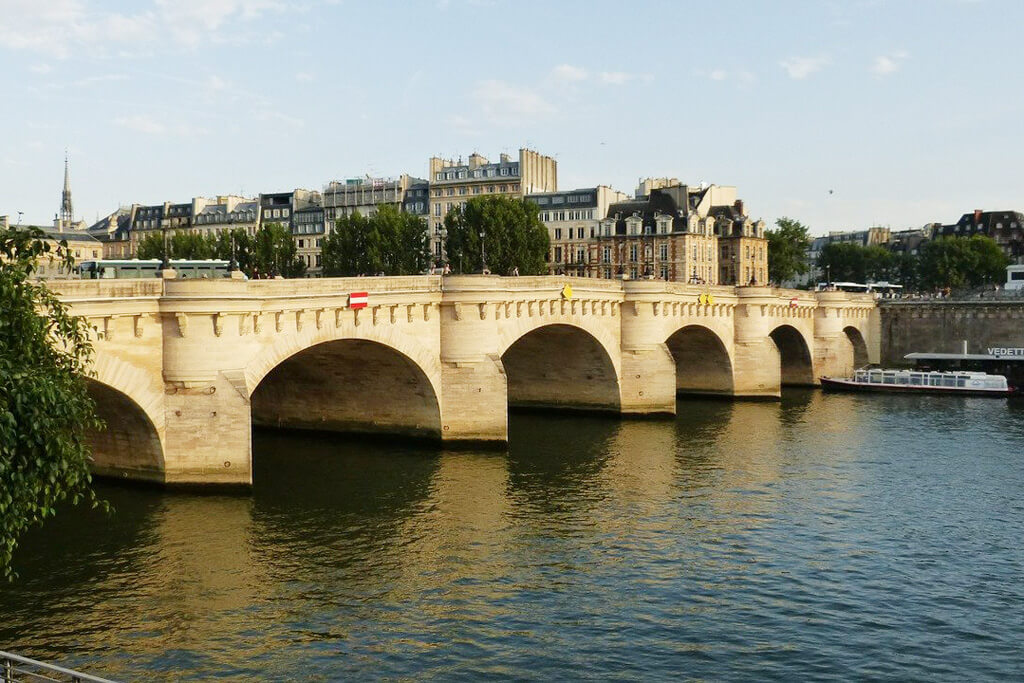
Built in 1578 under the reign of King Henri III, the Pont Neuf is 232 meters long and boasts a design that reminds of earlier Roman structures.
Despite its name (new bridge in French), Pont Neuf is the oldest bridge in Paris and the first one built in stone. Before, the bridges were made of wood.
Once off the bridge, look to your right, and you’ll see the Statue of King Henri IV, the next stop of this walking tour.
2. Statue of King Henri IV
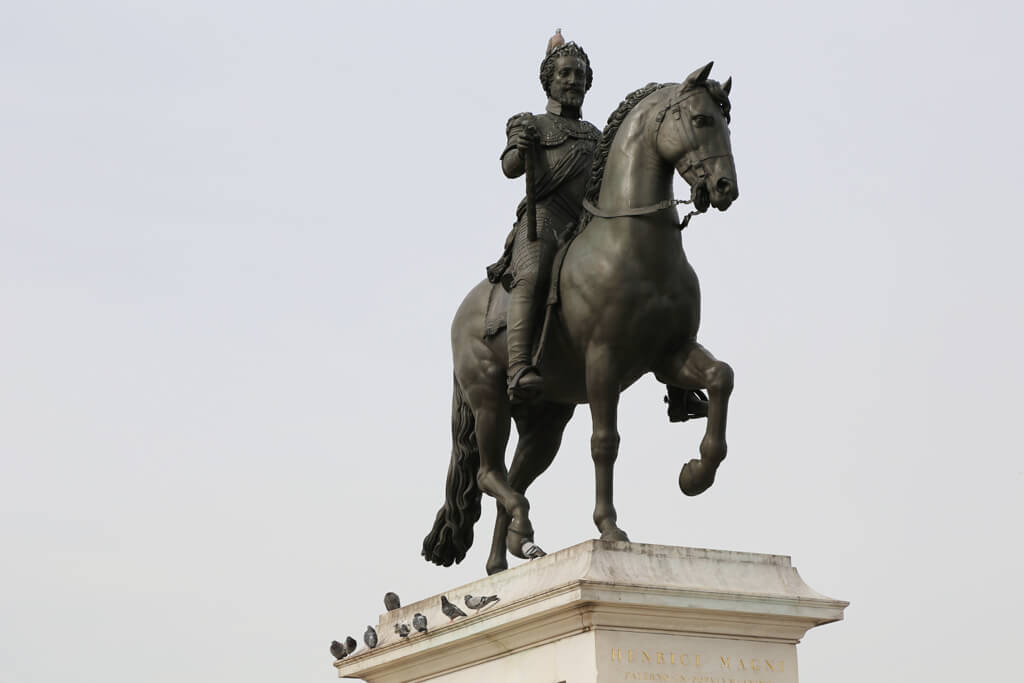
It’s impossible to miss the equestrian statue of King Henri IV, monarch of France. Queen Marie de Médicis commissioned this statue to pay tribute to the King, her husband. Unfortunately, King Henri IV never saw the completion of the statue as he was assassinated in 1610.
The equestrian statue we visit today is not the original bronze one, as it was destroyed during the French Revolution. The current version dates back to the return of the Bourbons in France, and it was made by melting several statues of Napoléon I and his generals.
There are many legends about the statue of King Henri IV that you can discover by checking out this post.
The next stop of this walking tour, Square du Vert Galant, is right behind the King Henri IV statue.
3. Square du Vert Galant
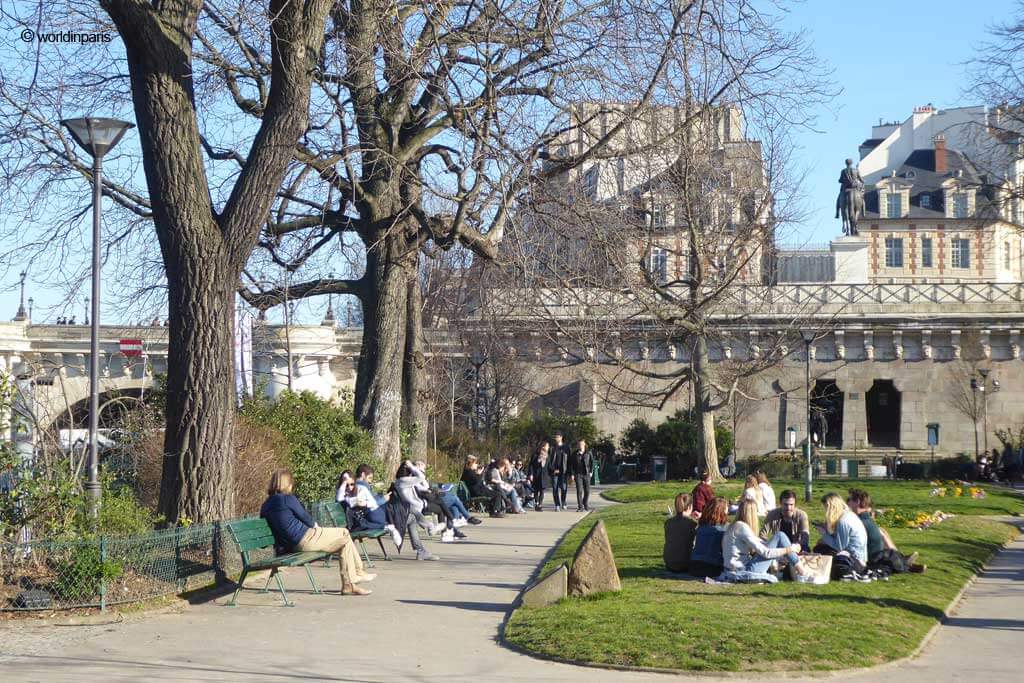
The Square du Vert-Galant was named after King Henri IV. The King was nicknamed the “Vert Galant” (Green Galant), an expression used for a man of advanced age who had not lost his sexual appetite.
This square is a perfect spot to sit and relax while watching the Seine River cruises pass by. The lovely Square du Vert-Galant is historically relevant as it is where the last Templars were burned.
In addition, it obtained the “Ecological Green Space” label in 2007 due to its impressive variety of fauna and flora.
Walk back to the Statue of Henry IV and pass by it. Keep going straight, and you will be at Place Dauphine in a minute.
4. Place Dauphine
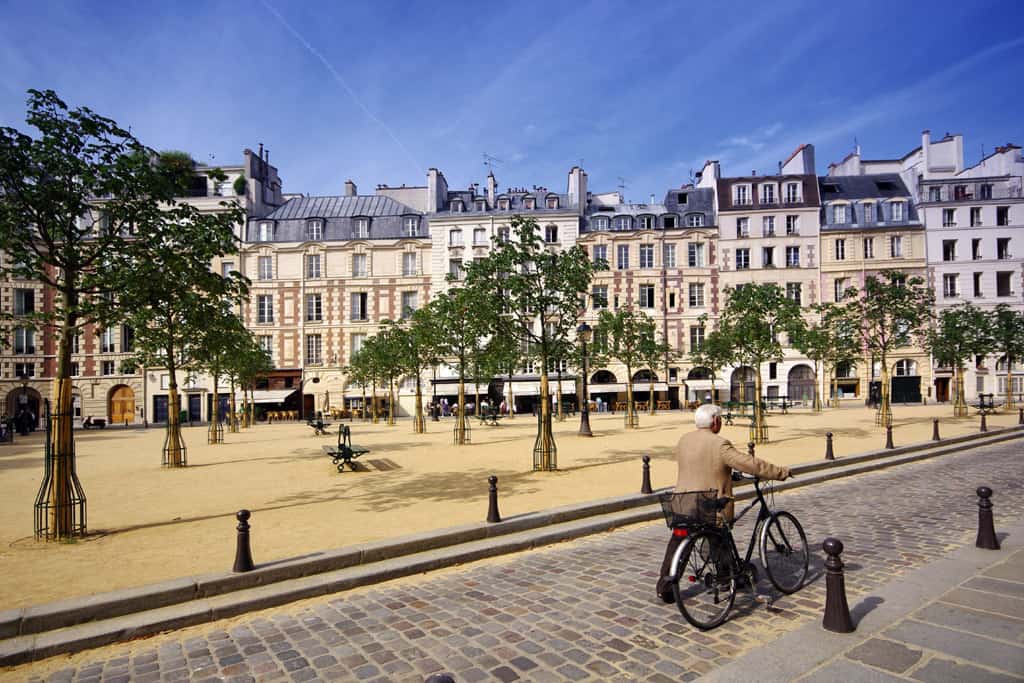
One of the Royal Squares in Paris, Place Dauphine was commissioned by King Henri IV in 1607 in honor of his son, the Dauphin of France, the future King Louis XIII. Around this triangular square are 32 identical houses in white stone and brick with slate roofs.
Place Dauphine is a great spot for a coffee break and people-watching. It is common to see some people playing pétanque in this square.
From Place Dauphine, walk to Quai des Orfèvres by turning your back to the King Henry IV Statue. In 7 minutes, you will be at the Palais de la Justice.
5. Palais de la Justice
The Ile de la Cité was the seat of important powers. In the eastern part, there was the religious power, and in the western part, there was the state power. The Capetians were the first kings to settle on Ile de la Cité, where they built the Palais de la Cité around the end of the 10th century.
In the 14th century, Charles V was the last king to live in the Palace. The kings of France then lived in the Louvre Palace and the Hôtel Saint-Pol in Le Marais.
After Charles V, the Palace became the Palais de Justice or Courthouse. It covers 4 hectares and has 24 kilometers of corridors.
What you see here is the Palais’ west façade, built in the 19th century. In the past, this façade must have been the entrance to the Courthouse, which is why it is the only one on which the name “Palais de Justice” is inscribed.
The architects of this façade were inspired by the ancient Egyptian temple of Dendera: trapezoidal door, sideboard wall (below the windows), and fluted columns surmounted by female figures. It is adorned with six statues that represent (from left to right) prudence, truth, punishment, child protection, strength, and fairness. Above, there are symbols of justice and two eagles, which remind us that this façade was built under the reign of Napoleon III.

6. Monogram and Medallion of Napoléon I

While doing the walking tour, I suggest you stop for a few minutes on the extremity of the west façade of Palais de la Justice to admire the medallion of Napoléon I and the monogram.
Unique of its kind, the bas-relief medallion honors Napoléon I, who, as the First Consul of the Republic, had brought to completion the French Civil Code (1804). Known as the Napoleonic Code, it is still in force in France, although it has been modified since its inception, and was the main influence on the 19th-century civil codes of most countries of continental Europe and Latin America.
The Tour de l’Horloge, the next stop of this Ile de la Cité tour, is at the corner between Boulevard du Palais and Quai de l’Horloge. You can get there in just 1 minute.
7. Tour de l’Horloge
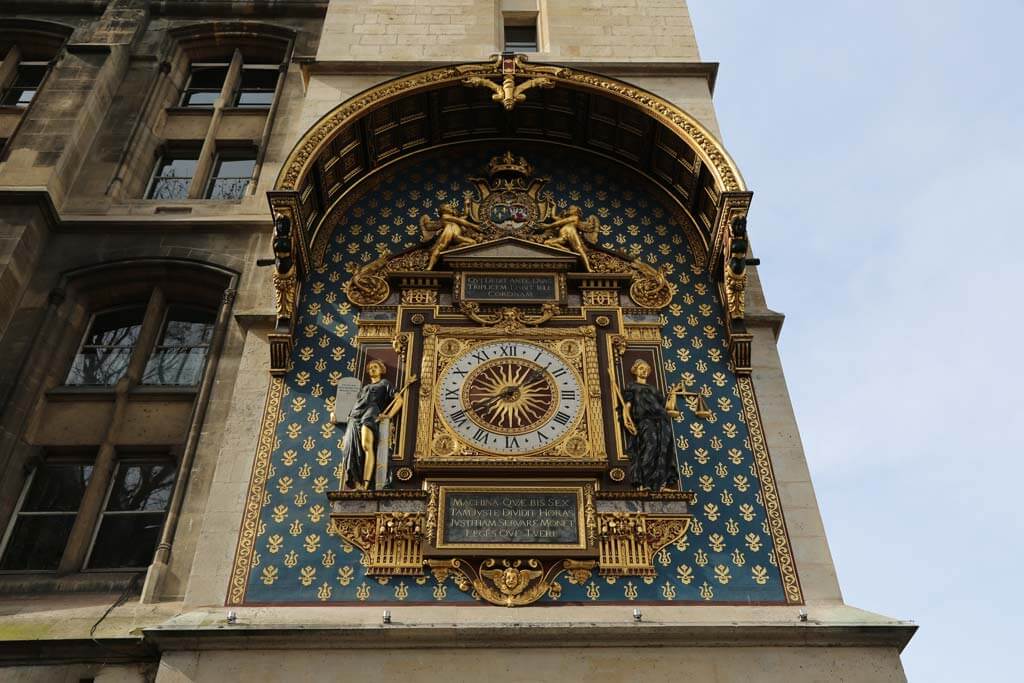
The Tour de l’Horloge is one of the towers of the Palais de Justice in Paris. Its main attraction is the stunning clock that gives it its name.
This clock, shining with its gold elements, dates back to the 14th century. What’s surprising is that it survived unscathed during the French Revolution, when many other sites around Paris were dismantled.
The Conciergerie, the next stop of this walking tour, is between the Palais de la Justice and Tour de l’Horloge.
8. Conciergerie
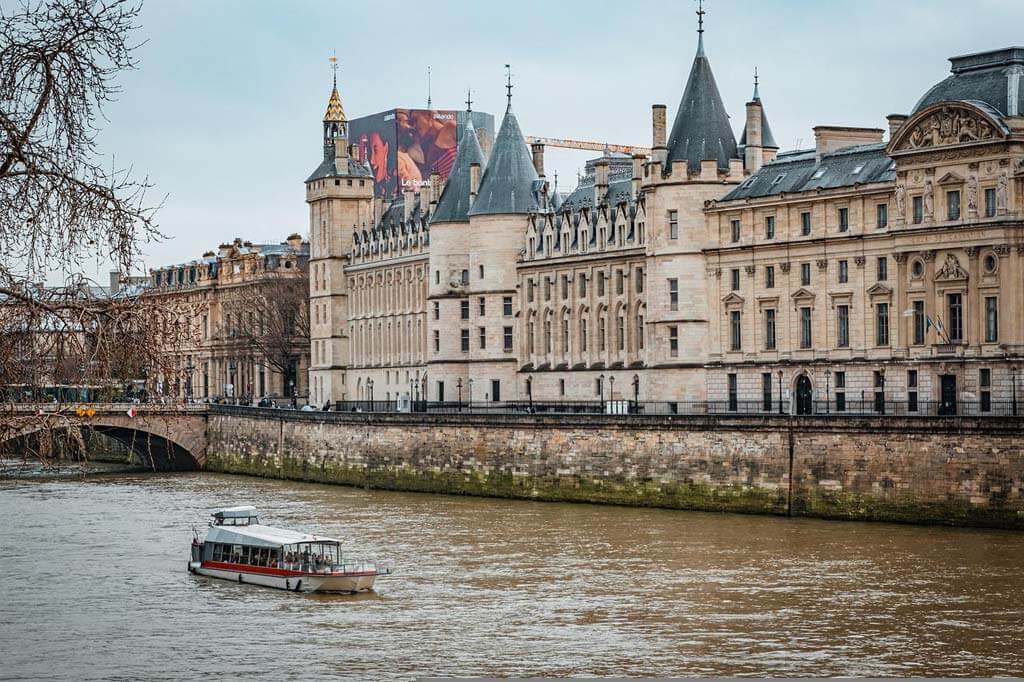
The Conciergerie was originally part of the Palais de la Cité, which also included the Sainte-Chapelle.
With the conversion of the Royal Palace into a Courthouse, prison cells were gradually added to the lower parts of the building, which became known as the “Conciergerie.”
If possible, visit the Conciergerie inside: it still keeps impressive rooms and halls from Medieval times, when it hosted the royal family. Their architecture, in Gothic style, is magnificent! The bundle Conciergerie + Sainte-Chapelle will save you time.
A part of the palace was successively converted into a prison. Its most famous prisoner was Marie-Antoinette, who spent there her last days of life before being sent to the guillotine.
Sainte Chapelle sits right next to the Conciergerie.
9. Sainte Chapelle
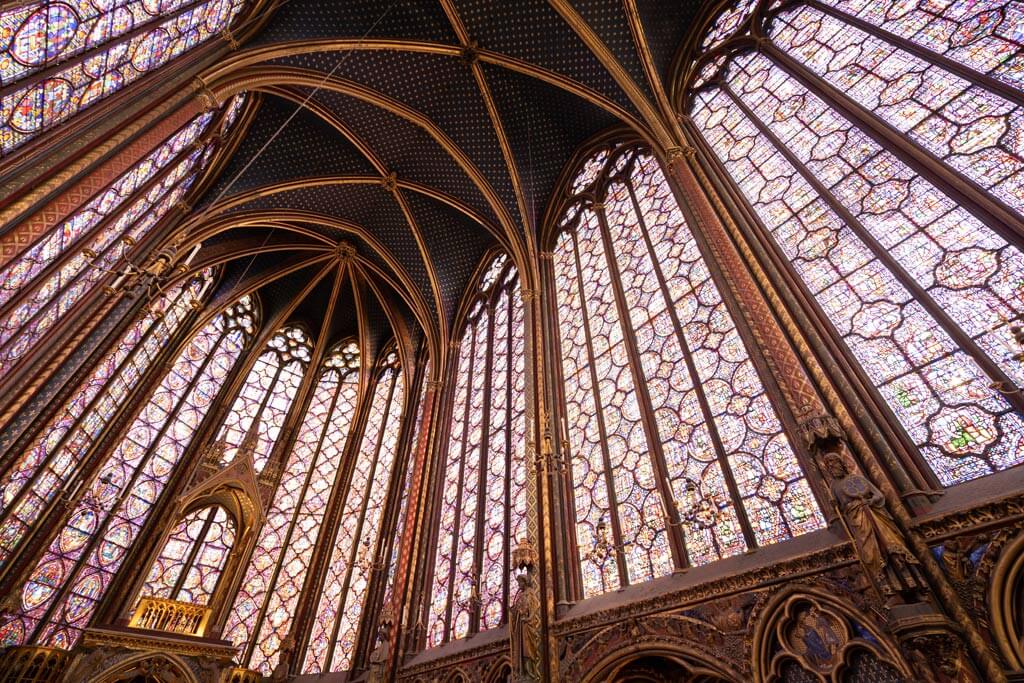
One of the most unique places to visit in Paris, the Sainte Chapelle, was originally part of the Palais de la Cité. King Louis IX (Saint Louis) commissioned it to house treasured Saint relics.
The Sainte Chapelle is a fine example of Gothic architecture, with high vaulted ceilings and windows telling the story of the Bible and how the Saint Relics came to Paris.
The most impressive feature of the Sainte Chapelle is its exceptional collection of stained glass windows, which are truly breathtaking when viewed from inside the Chapel.
Cross Boulevard du Palais and take Rue de Lutèce. Turn onto the first narrow street on the left, and you will find yourself at the Marché aux Fleurs.
10. Marché aux Fleurs
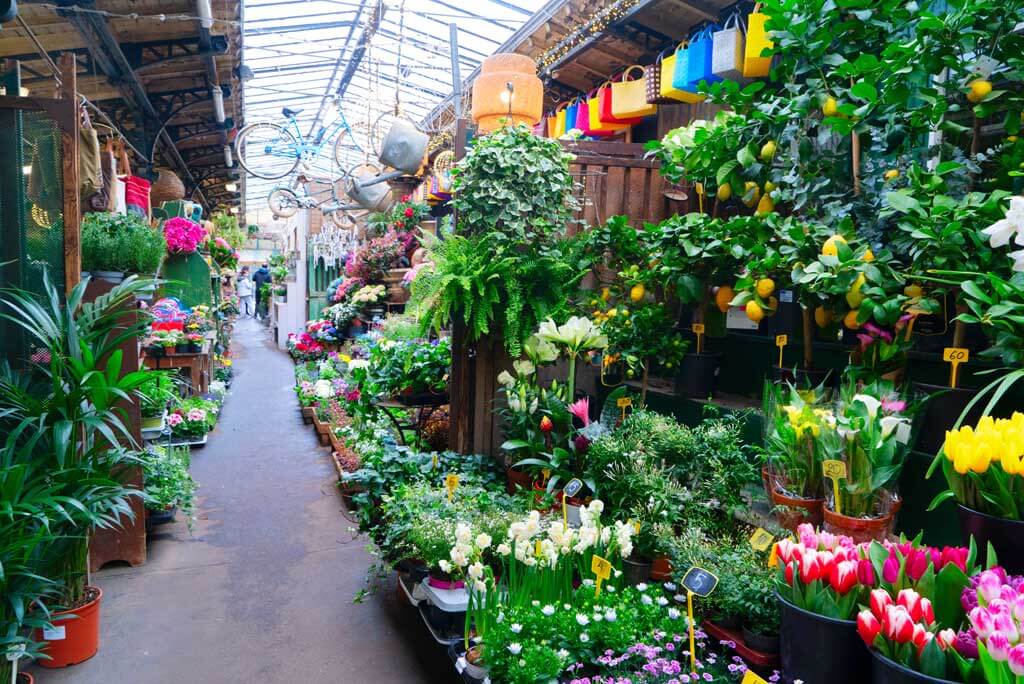
The Marché aux Fleurs, also known as Marché Reine Elisabeth II, is one of the prettiest flower markets in Paris. Opened around 1808, it has sold colorful flowers and a dazzling array of plants ever since.
In the past, this place was also where Parisians would come to purchase birds, which is why its former name was the Marché aux Fleurs et aux Oiseaux.
The market is indoor and outdoor, with stalls housed in 1900s-built pavilions.
From the Marché aux Fleurs, head to Rue de la Cité and follow it for 5 minutes until you arrive at the Notre Dame Cathedral. The access to the Crypte Archéologique is right in front of the Cathedral.
11. Crypte Archéologique
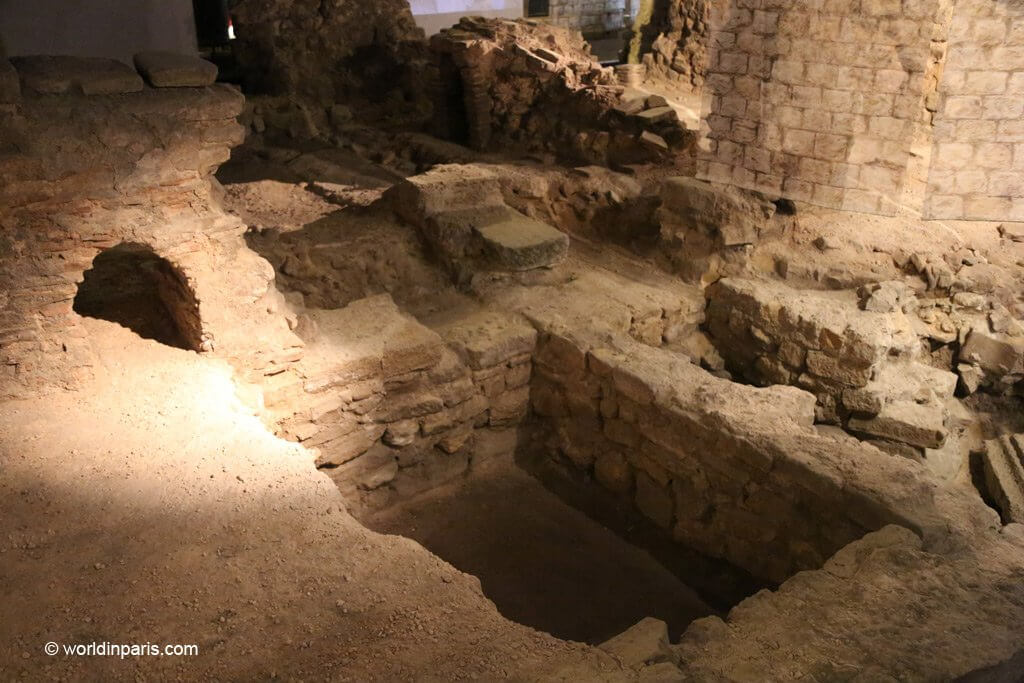
While Notre Dame Cathedral will surely get your attention immediately, you should first visit the Crypte Archéologique, one of the most fascinating sites of underground Paris.
This under-the-tourist-radar spot is perfect for immersing yourself in Paris’s history. The 200-meter-long crypt contains archeological findings from the Gallo-Roman era to the Middle Ages to the 19th century.
It is the largest crypt in Europe, and to make visitors’ experience more immersive, there are interactive maps and 3D animations.
In particular, you will discover part of the docking port of the Gallo-Roman city of Lutetia, the basement of the former Hôtel Dieu Chapel, and the remains of the Rue Neuve-Notre-Dame. There are also Roman baths.
Notre Dame Cathedral is right behind the Crypte Archéologique.
12. Notre Dame Cathedral (Notre Dame de Paris)
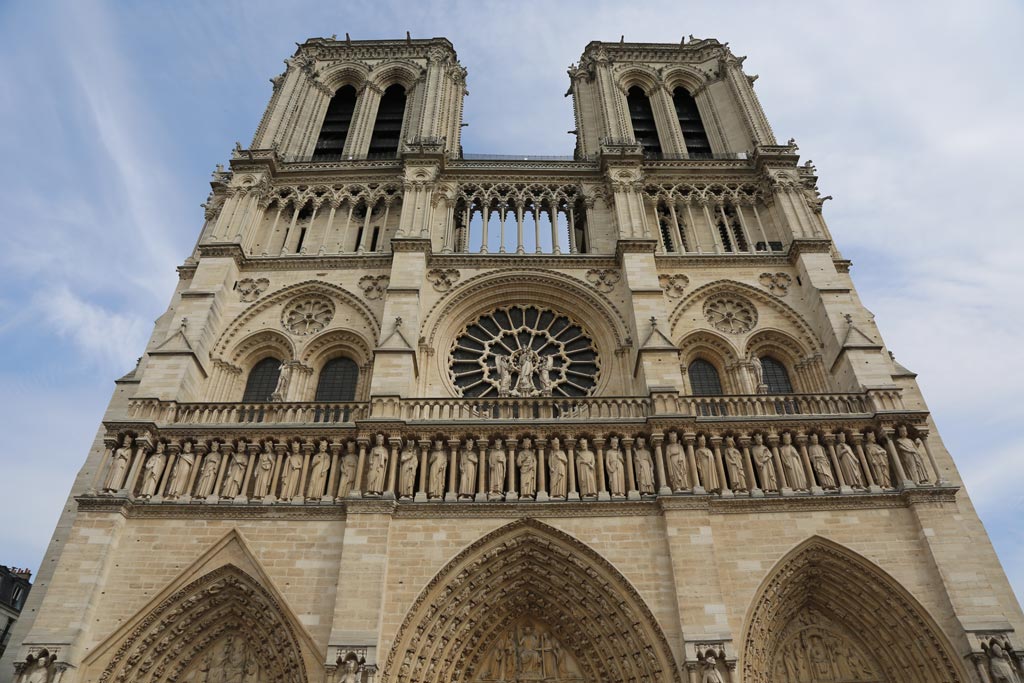
One of the main landmarks in Paris, Notre Dame Cathedral was constructed in the late 12th century but completed only 200 years later. It is one of the first Gothic cathedrals in the world, built only after the Basilica of Saint-Denis.
Notre Dame Cathedral boasts a stunning exterior facade with high spires and stone-built gargoyles. The interior is just as astonishing, with beautiful stained glass windows and a panoramic rooftop.
After 5 years of restoration works, visits inside resumed in December 2024. Here’s how to visit Notre Dame after the reopening, as well as some insider tips.
Leaving the Notre Dame Cathedral behind you, take the street on the right, Rue d’Arcole, and walk straight for 2 minutes. When at the corner with Rue Chanoinesse, take it, and you will be at your next stop.
13. Au Vieux Paris d’Arcole
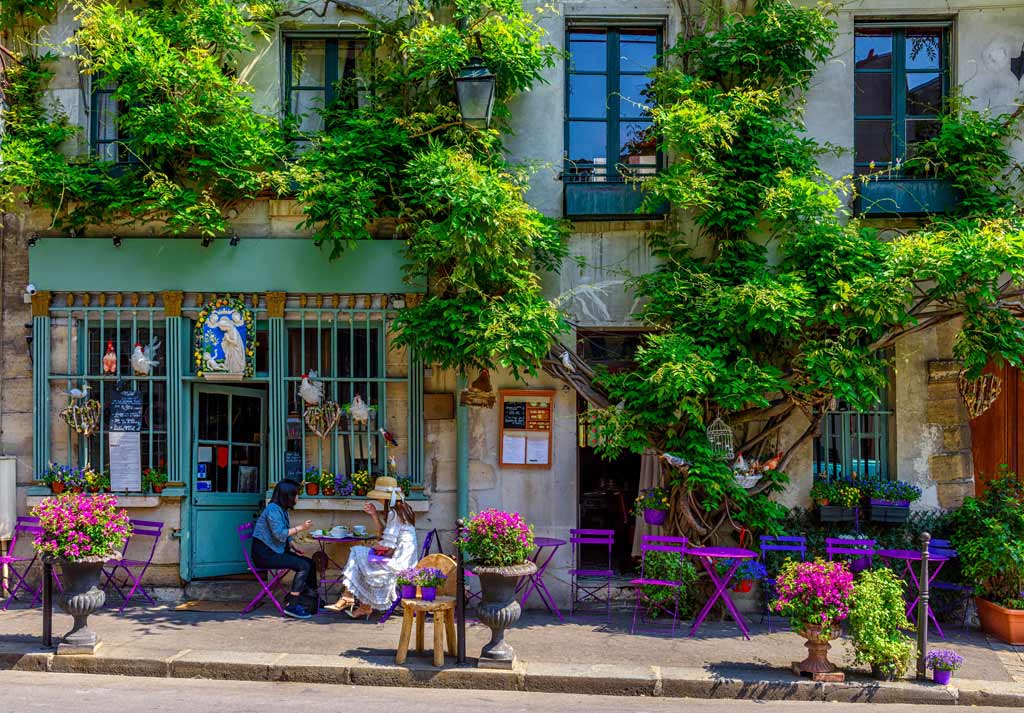
The next stop of this walking tour is one of the most photographed places in Paris. Au Vieux Paris d’Arcole on 24 Rue Chanoinesse is particularly charming when the wisterias that decorate its façade are in full bloom.
Built in 1512, it was the residence of the canons of Notre Dame, one of whom was the future Clément VIII, Pope of Avignon. The house was sold in 1723 and then became a wine bar. You can still see the fence at the entrance, which was once mandatory for liquor sellers.
Today, Au Vieux Paris d’Arcole is a café (on the ground floor) and a restaurant (on the first floor) offering great French cuisine. Because of its history, it is listed as a Historic Monument.
The next stop, Rue de la Colombe, is 1 minute from Rue Chanoinesse.
14. Rue de la Colombe
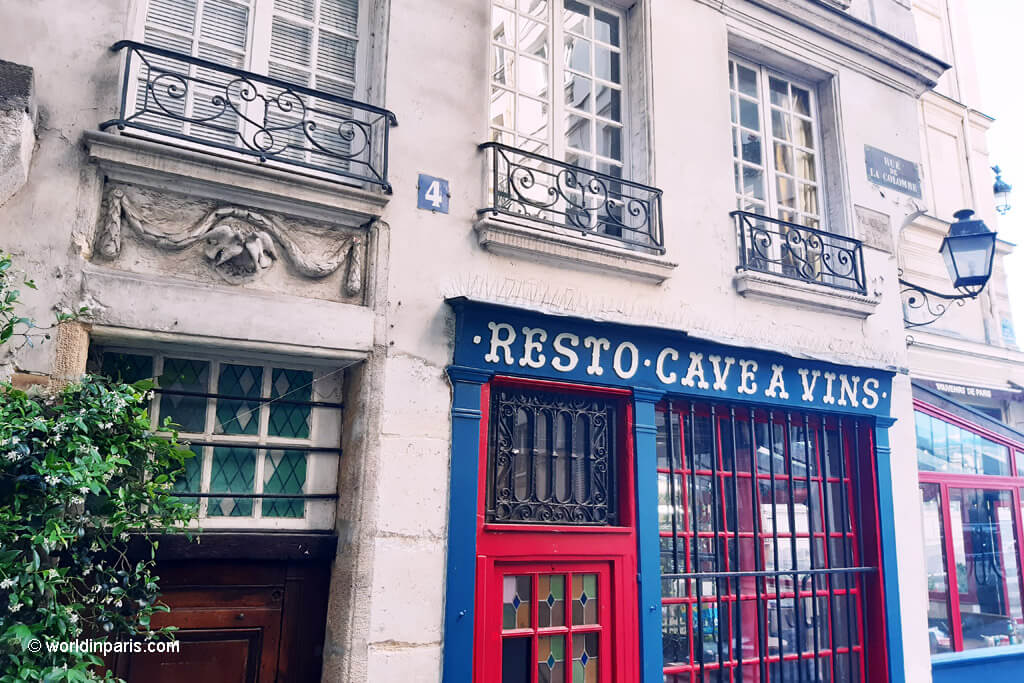
Rue de la Colombe (“Dove Street” in English) is an old narrow street where you can see the remains of the first wall of Paris, which was raised in 276 CE and survived the Barbarian invasions.
Located at number 4 on this street is also the Maison de la Colombe, the oldest bistrot in Paris, The building where the bistrot is surrounded by an interesting legend. If you are curious to know all about it, check out this post!
Quai aux Fleurs, the next stop of this Ile de la Cité walking tour, is the street perpendicular to Rue de la Colombe, walking toward the Seine River. You can get to it in just 3 minutes.
15. Héloïse’s Former House

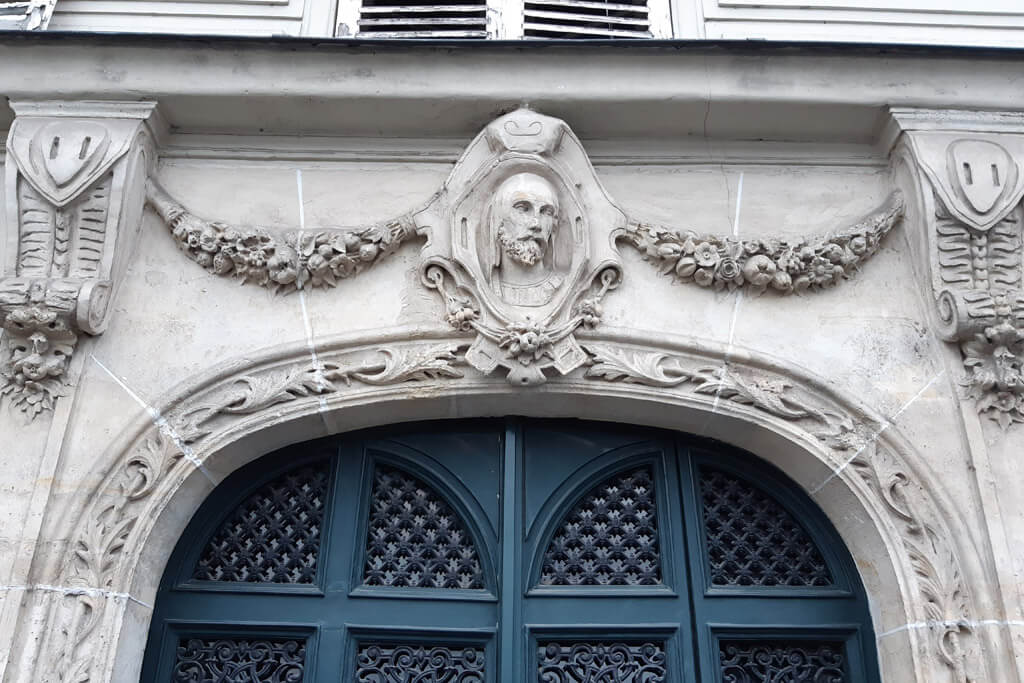
At number 11 of Quai des Fleurs is the former House of Héloïse, the Parisian Giulietta. Her love story with Abélard is one of the most famous of Medieval times.
The building is decorated with the beautiful bas-relief of the two lovers, whose tragic love story you can read about in this post.
You can visit the tombs of Héloïse and Abélard at the Père Lachaise Cemetery, one of the most stunning in Paris.
Walk Quai des Fleurs all the way to its end toward Pont Saint-Louis, and you will arrive at Square Ile de France.
16. Square Ile de France
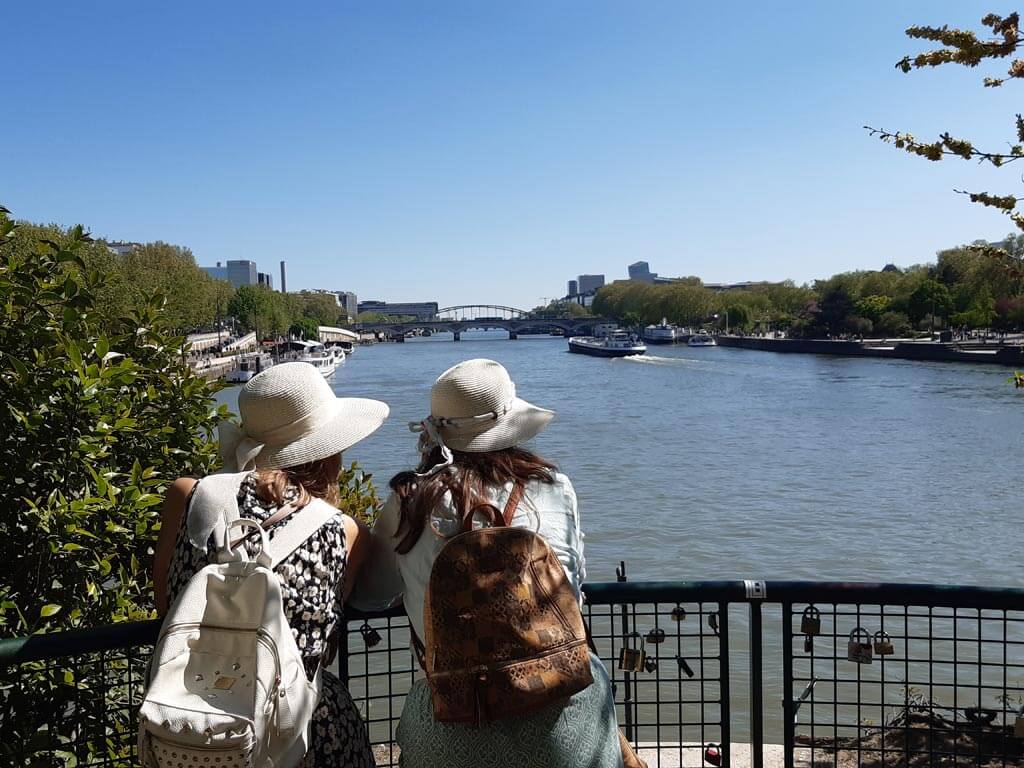
The last stop of this walking tour is the lovely Square Ile de France. Its history started in the 14th century when it was used as a dump for the rubbish accumulated after the construction of Notre Dame Cathedral.
By 1687, the area was transformed into a garden reserved for men, part of the enclosure of the Cathedral’s canons.
Things changed again in the 19th century when the square became the site of the Morgue of Paris. The morgue was open to the public so everyone could go there to try to recognize unidentified bodies found in the Seine or elsewhere in the city.
The Morgue of Paris became an unusual and favorite attraction for locals, with more than 40,000 daily visitors! Today, there’s a grade from which you can enjoy beautiful views of the Seine River, the Pont de la Tournelle, and Ile Saint-Louis.
Also on this square, you will find the Deportation Martyrs Memorial, one of the main WW2 sites in Paris. This memorial honors the about 200,000 French citizens who were deported to German concentration camps.
If you are in the mood for more walking, cross Pont Saint-Louis to visit Ile Saint-Louis. You can check out my post on the best things to do in Ile Saint-Louis for some inspiration. Alternatively, you can continue exploring Paris’ Left Bank by taking this Latin Quarter walking tour.

